Translation of the chapter selected from the Handbook of Professional baristas | Chapter 6 drip coffee
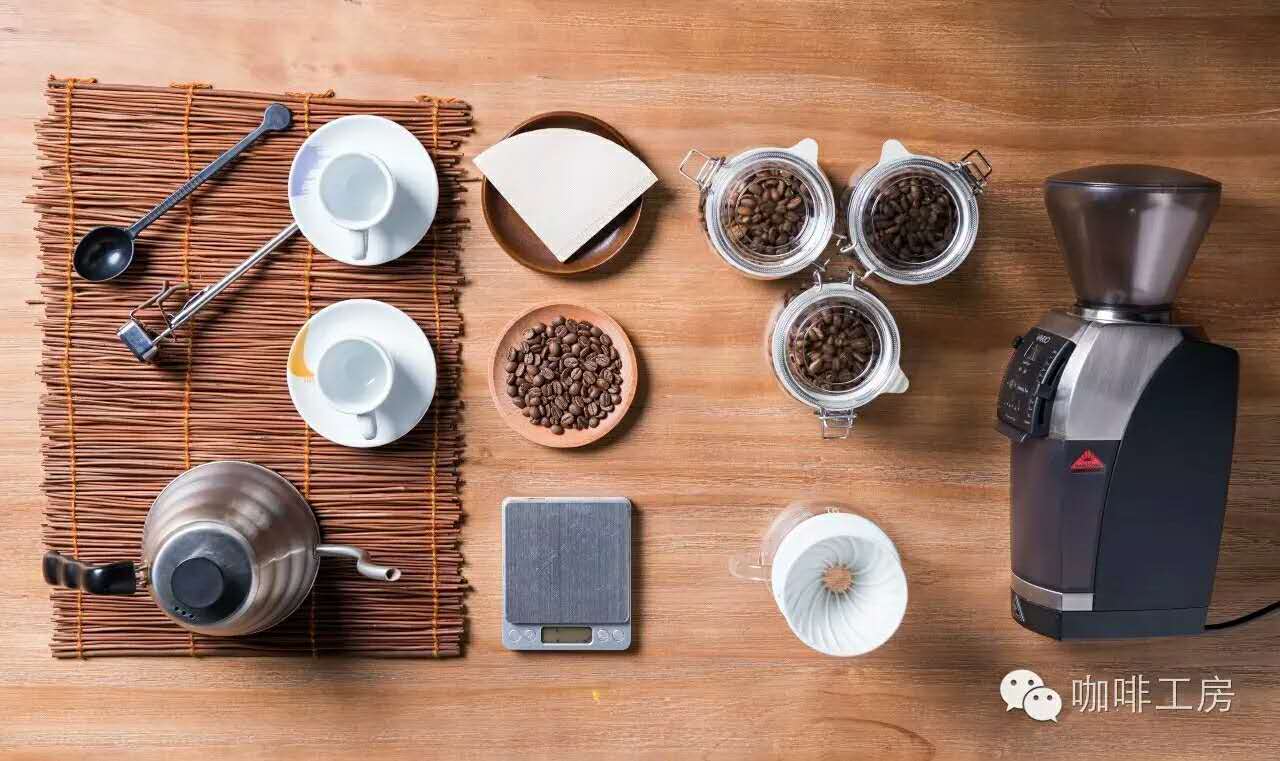
For professional baristas, please follow the coffee workshop (Wechat official account cafe_style)
Freshness
Drip coffee is notorious all over the world for a variety of reasons. The drip-filter coffee sold in many places has been heated in a pot for a lifetime and tastes light and bitter. There are also some "boutique" coffee suppliers who make the mistake of operating multiple types of coffee beans at the same time, spreading down the inventory conversion rate of each kind of beans, making the beans stale. Ironically, coffee made by consumers with a $20 machine at home is better and cheaper than a coffee made by a merchant with a $3000 machine, at least fresh coffee at home every time.
To enhance the production of drip coffee, the easiest thing a coffee shop can do is to keep the coffee fresh. The following points will allow you to provide fresh coffee.
No matter how busy your cafe is, please don't brew more than one kind of coffee at the same time.
The amount of brewing should be as small as possible, as long as it is not always sold out.
Teach your staff to make new coffee only when necessary, not to make a spare pot without thinking about it, or to make it as soon as you see the coffee pot empty
If you are using a glass pot or an uninsulated metal pot, replace it with an insulated container that can be sealed
Even if you do all of the above, you still need to define a time limit for pouring out the brewed coffee. I think it's an insult to let a customer spend $1.25 to $1.75 on a cup of coffee brewed for more than 30 minutes. If you don't think it's worthwhile to pour out old coffee, think of a restaurant that serves expired food. If you still don't think it's worth it, try drinking coffee for an hour in the next few weeks. If you still think it's not worth it, then you are a profiteer.
Teaching your employees to pour out old coffee without hesitation can also be a good selling point. Let the customer see how much coffee you have poured out to ensure freshness.
With the gradual increase in sales, this freshness standard will actually be paid for by customers. At the same time, the increase in sales will also make coffee less wasteful.
Standard for drip coffee brewing
The Coffee brewing Society (later the Coffee Brewing Research Center) has been in use since the establishment of the brewing standard for drip coffee in the 1950s and 1960s. The author wanted to find out the original version published by the coffee brewing center, but could not find it. So the criteria listed below are from the second-hand data after CBC processing:

The examples discussed in this chapter use this standard brewing by default.
Extraction rate of soluble matter, brewing strength, flavor
The brewing strength of drip coffee refers to the concentration of soluble matter in the cup. Concentration does not represent the quality of the flavor, but it can affect the taste of the flavor. If the concentration is too high, it will affect the drinker's taste and inhibit the subtle flavor.
The extraction rate of soluble matter refers to the weight of the soluble matter brewed, which is divided by the weight of coffee powder before brewing and expressed as a percentage. The proportion of different soluble substances in water is different, therefore, under different extraction rates, the components of soluble substances extracted are different, and the flavor characteristics are also different. This can be sampled and tested at different time points in the brewing process to get the most intuitive experience.
The coffee with low extraction rate has a high proportion of water-soluble substances, and the taste tends to be fermented, sour, bright and fruit. Coffee with a higher extraction rate improves the balance through substances that are insoluble in water, reduces acidity, increases sweetness, and improves caramel flavor.
Control extraction rate and concentration
The relationship between extraction rate and concentration may be a bit confusing, but the following table will outline how to control the extraction rate and concentration by changing the grinding scale and powder-to-water ratio for ease of reading.
Grinding
A more uniform grinding can extract the best dripping coffee. The difference in particle size is too big, which will lead to excessive extraction and insufficient extraction in some parts of the powder bed.
The most suitable degree of grinding is best determined by blind measurement, and the test data can be supplemented by measuring the concentration with a TDS meter. If the coffee tastes bitter, astringent, and the tongue is dry, it is extracted too much, because the degree of grinding is too fine; if it tastes light and watery, the degree of grinding is too coarse; if it tastes excessive and light, then the knife head of the bean grinder may be blunt and need to be polished or replaced.
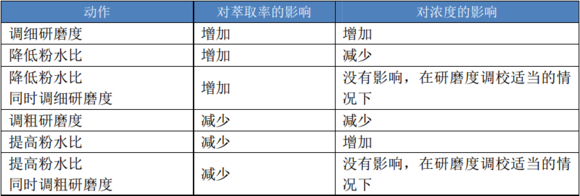
In addition to taste tests, the degree of grinding can also be set by observing the wet powder pile after brewing. If the beans used are ground within 3 to 7 days of roasting and before brewing, most of the top area of the wet powder pile should be covered with foam.
·If there is little or no foam, and the powder pile is only slightly wet (similar to wet sand), the grinding is too coarse.
·If the top is pitted or slimy, grind too fine.
·If some part of the pile is dry, the grinding is too fine, the top layer of the bed is too close to the sprinklers, or some sprinklers are blocked.
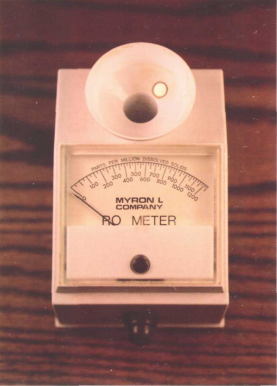
TDS measuring device (translator: so old. )
Temperature
The temperature of brewing water should be between 195 and 205 degrees Fahrenheit (90.6 to 96.1 degrees Celsius), depending on the baking degree of beans, the ratio of powder to water, and the desired flavor. The effect of brewing water temperature on extraction can be briefly summarized by several points:
The higher the temperature, the more sour, bitter, mellow (body), astringent taste.
High temperatures generally lead to a higher degree of extraction because it increases the solubility of substances that can only be dissolved at high temperatures. The same applies to Italian enrichment (espresso).
The solubility of different substances is also different at different temperatures. This shows that the temperature brings not only the difference in the total concentration of all soluble substances, but also the difference in the relative concentration of different soluble substances.
Turbulent flow
Turbulence is a combination of coffee powder, gas and hot water, which is caused by the gas released by coffee powder when hot water comes into contact with coffee powder. Turbulence can slow down the velocity of hot water passing through the coffee powder, prolong the wetting time of the coffee powder, and foam the top of the wet powder pile after brewing.
Moderate turbulence is very important because it allows coffee particles to rise and separate evenly, improving the uniformity of water flowing through the powder bed. In addition, turbulence can also provide a moving target for the sprinkler, lest the sprinkler always favor a certain piece of coffee powder, thus improving the uniformity of the extraction. But too much turbulence is a problem because it can excessively prolong the soaking time of coffee powder, causing the water to flow too slowly through the powder bed, leading to excessive extraction.
If cafes always use coffee beans four to six days after roasting for brewing, then turbulence is not a concern. But when cafes face inventory problems, and coffee beans are roasted for more than 10 days, or less than 2 days, it is necessary to correct the unusual amount of turbulence.
After roasting coffee beans for more than 10 days, the turbulence becomes less, so you need to adjust the grinding degree to slow down the flow rate; if the coffee beans are roasted for less than 2 days, the turbulence will be too strong, and baristas have three options to correct it.
1. Adjust the degree of grinding. However, using a thicker degree of grinding to correct the turbulence is not the best choice, because it will change the flavor of the final product.
two。 Grind the coffee beans for a few hours before brewing. Many coffee experts will reflexively think that this is absurd, but doing so is equivalent to putting coffee in the form of whole beans for a few days.
3. Use a larger pre-soaking ratio and lengthen the pre-soaking time, if the coffee maker has these options. (for more information, see the chapter "automatic brewing settings" in this chapter)
Optimization of different batch sizes
Each machine and basket has a range of the most suitable batch size, depending on the diameter and shape of the basket, the design and flow rate of the sprinkler distance, the size of the drain hole at the bottom of the basket, and the permeability of the filter. The most critical factor is the diameter of the filter basket, because it can determine the height of the powder bed, thus determining the appropriate degree of grinding and contact time of powder water. The larger the filter basket, the larger the corresponding optimal batch size.
For example, the author has previously used a 1 gram 2 gallon filter basket, which is most suitable for extracting 2pm 3 gallons to 1 gallon (2.5 liters to 3.78 liters) of coffee. The author also has a cylinder coffee machine with a large filter basket, which is most suitable for batches of 1 to 2 gallons (about 1.89 liters to 3.78 liters). The two have one thing in common: the powder beds held by the two filter baskets are highly similar.
In order to achieve the established extraction rate and concentration, the higher the powder bed, the thicker the coffee powder; the shallower the powder bed, the finer the coffee powder. This is because the high powder bed creates more resistance to the flow of water, making the powder contact with water longer. Batches whose size exceeds the optimal range require a particularly fine or coarse degree of grinding to achieve a given concentration, but such a degree of grinding will make the contact time of powder water too long or too short, affecting the flavor.
At present, there is no consensus on the best powder bed height, but the powder bed height recommended by the Coffee Brewing Research Center is 1 inch 2 inches (2.54 cm to 5.08 cm).
How to brew small batches
To brew very small batches, it is best to use small tapered baskets or metal mesh baskets. These two kinds of filter baskets can reduce the average diameter of the filter basket, increase the height of the powder bed, and better accommodate the coarsely ground coffee powder than other types of filter baskets in very small batches.
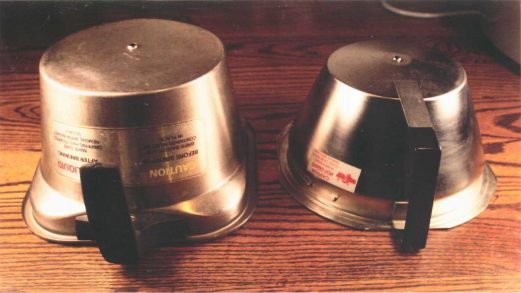
Both filter baskets are designed for the same machine, and the filter basket on the right is more suitable for smaller batches.
How to brew a large batch
If you want to make a large batch of coffee with a high powder bed, you need to open the shunt valve. The shunt valve can change the direction of the water around the filter, allowing the water to bypass the coffee powder. The use of a shunt valve is equivalent to using a very high powder-to-water ratio to achieve a normal extraction rate and a very high concentration, and then reducing the concentration by adding water directly to the pot. In a word, it is to dilute the high concentration of coffee with hot water.
If the powder bed is high and there is no shunt valve available. Then it is necessary to use more than ordinary rough grinding to limit the contact time of powder and water and prevent excessive extraction. There are several problems with trying to use very rough grinding to deal with extremely high powder beds.
It will affect the flavor.
It will make the extraction somewhat uneven because the particle uniformity of very coarse grinding is low.
Sometimes the bean grinder does not have a scale that is fine enough to provide the necessary concentration and thick enough to prevent excessive extraction from the filter basket.
Shunt valve
The author refused to use the shunt valve for 12 years because I didn't believe it could make good coffee. Until one day my friend, Tony, owner of the Chicago Metropolitan Cafe (MetropolisCoffee), told me that he had had a great coffee in a store in Michigan, which was made by opening the 50% shunt valve! Only then did I realize that I should learn how to use the shunt valve.
The shunt valve works because it can use finer grinding than other methods when the powder bed is high. In the absence of a shunt valve, the use of "normal" grindness on a high powder bed will lead to excessive extraction, resulting in very high extraction and concentration. However, after using the shunt valve, the amount of water passing through the powder bed becomes smaller, which effectively prevents excessive extraction and allows the appropriate grinding degree to be used.
How to determine the setting value of shunt valve
For a fixed batch size, experiments are needed to determine the ratio of the shunt valve to open and how to set the degree of grinding. One way is to determine the degree of grinding first and use your machine to make the best degree of grinding for coffee without using a shunt valve in a normal batch size. Then the proportion of the shunt valve opening is estimated through the weight difference between the new batch and the previous normal batch. The degree of grinding is closely related to the flavor. Although a fixed degree of grinding may not necessarily make the flavor of the "normal" batch exactly the same as that of the larger batch using the shunt valve, it can at least reach nine times out of ten.
The final choice of grinding degree and shunt valve opening ratio should be determined by the taste, and you can also use the TDS meter to help you find the best setting value.
The method used to determine the appropriate opening ratio of the shunt valve when the degree of grinding is fixed:
1. Write down the parameters that make the best coffee in normal batches on paper (grindness, powder-to-water ratio, batch size, concentration).
two。 Determine the size of the new batch using the shunt valve.
3. Calculate how much the new batch is larger than the normal batch. Ex.: a 1.4-gallon batch is 40% larger than a 1-gallon batch.
4. As a first attempt, set the shunt valve opening ratio to half of that calculated in step 3. Continue the previous example: the 1.4 gallon batch should open the shunt valve by 20% to brew.
5. Brew new batches, taste, and measure TDS. If the TDS (concentration) is too high, increase the shunt valve opening ratio; if the concentration is too low, reduce the shunt valve opening ratio.
6. Continue to brew new batches and adjust the shunt valve setting until the product reaches the desired concentration.
7. When you have successfully brewed a batch, record the batch size, powder-to-water ratio, grinding degree, shunt valve setting, and concentration.
8. For ambitious and leisurely authentic coffee geeks, you can repeat the above steps for a variety of batch sizes, all using the same degree of grinding. Draw a picture, the horizontal axis is the batch size, and the vertical axis is the shunt valve opening ratio. Mark the successful batches on the diagram, connect the marked points into a line, and mark them as "grindness z". You can use this diagram as a reference tool for how to set the shunt valve opening ratio when using larger batches in the future.
9. Frame this picture and make a copy for your mother to keep.
Coffee product management table
We already know the relationship between concentration, extraction rate, and the ratio of powder to water. If the values of two of the parameters are confirmed, the third value can be calculated.
The relationship between them has been illustrated in exquisite graphic form by the Coffee brewing Research Center in the 1960s. You can save this picture and use it as a guide for you to evaluate different brewing parameters.
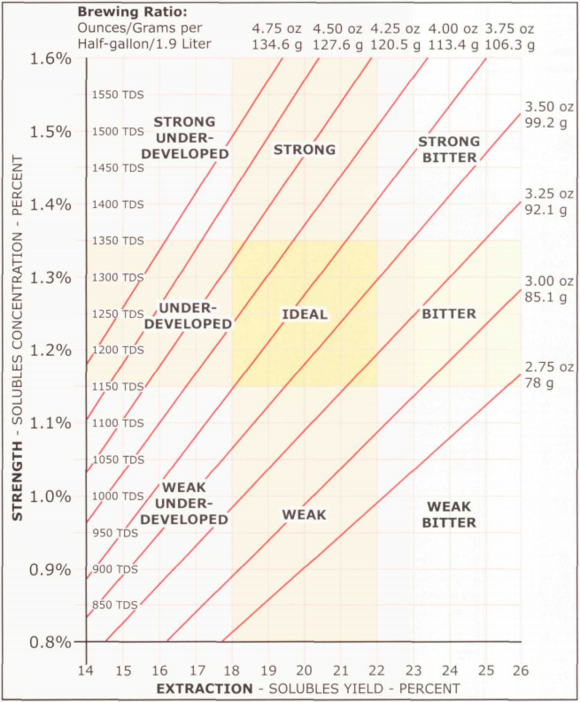
(translation note: this picture is the golden cup picture of SCAA, needless to say)
Device filter
Paper filters are the easiest to absorb odors during storage, adding miscellaneous flavors to coffee. In order to minimize the negative effect of the filter on coffee flavor, both the filter and the filter cup should be rinsed with boiling water before brewing. Washing can also wash off the residue in the filter cup and the next pot, and preheat the filter cup and the next pot.
When washing, first put the filter into the filter cup and put the filter cup into the coffee machine. Turn on the machine, pour the boiling water from the filter into the next pot, and turn off the flow after a few seconds.
After flushing the filter, fill in the coffee powder and shake the filter cup back and forth until the surface of the powder pile is as flat as possible. Be careful not to use too much force when loading the filter cup into the machine, as this may mess up the powder bed.
Stirring: the key to the best dripping coffee
In the brewing process of drip coffee, there are two disadvantages that will affect the extraction uniformity. First, all sprinklers have the greatest impact on an area on the surface of the powder pile, where coffee powder is overextracted and potholes are formed. Second, as with the extraction of espresso (espresso), the liquid flows from top to bottom, so that the priority of extraction is from the top to the bottom.
When the temperature of the liquid is very high, it has stronger solubility, dilution, and less viscosity. The liquid at the top is always hotter (at least as high) than the liquid at the bottom. The liquid at the top of the powder bed is always more dilutive and less viscous than the liquid at the bottom. As a result, the coffee powder at the top of the powder bed has a higher extraction rate.
Stirring coffee powder during brewing can greatly improve the extraction uniformity, alcohol (body), and concentration, while reducing bitterness. Stirring requires the use of a cylinder coffee machine or some household filter cups to facilitate access to the powder pile. About 5 to 10 seconds after brewing, the barista should gently stir the coffee powder with a large spoon or spatula, be careful not to pierce the filter and make sure to soak all the coffee powder. When the sprinkler stops filling, stir the coffee powder again. Each time you stir, stirring 3 or 4 times is enough.
The effect of the first stirring is similar to pre-soaking, which makes all coffee powder soaked uniformly almost at the same time, makes the temperature above and below the powder pile more consistent, reduces potholes and allows the bottom of the powder bed to participate in the extraction earlier.
After the first stirring, with the advance of the brewing process, the extraction uniformity began to decrease gradually. This is because the current is from top to bottom, and the sprinkler is constantly injecting water into the top of the powder pile, both of which have a greater effect on the extraction of the top of the powder bed. It should be noted that although the extraction uniformity began to decrease after the first stirring, the uniformity of stirring was higher than that of no stirring under the same extraction parameters.
As soon as the sprinkler stops filling, the barista will immediately start stirring again. This is the earliest time to stir, and there is no newly injected water to dilute and offset the benefits of stirring.
The second stirring redistributes the concentration of soluble matter in the powder bed and the extracted liquid. This time, it is more evenly distributed, speeding up the extraction of coffee powders that are also rich in soluble matter (which were previously at the bottom of the powder bed) because they are now surrounded by lighter extracted liquids. At the same time, the extraction of coffee powders with little soluble matter left (which were previously on top of the powder bed) has slowed down because they are now surrounded by less light extraction liquids. In this way, the extraction uniformity of the whole powder bed is greatly improved, and the bitterness, astringency and incomplete flavor are reduced.
When stirring is added to the brewing process, a coarse degree of grinding is required. The more powder to be stirred, the thicker the degree of grinding is required. No matter how many times you stir, it is best to keep the same number of times in each batch.
Automatic brewing programming setting
I often miss the days when I only need to worry about temperature and brewing capacity. Now a barista needs to programmatically control the amount of pre-soaking, pre-soaking time, split valve opening ratio, brewing time, and, of course, temperature and brewing volume. Faced with so many options, it can be said that it is a mixed blessing. I don't think anyone can fully understand how these parameters affect each other, so some of the machine manufacturers I've come into contact with have either powerless or wisely chosen not to provide automated programming advice.
Here is a basic idea for machine automation programming, but don't be too superstitious about these values. Remember, in the end, taste is the only important variable.
Pre-soaking water and pre-soaking time
Pre-soaking can wet the whole powder bed and raise the temperature of the powder bed, helping to improve the extraction uniformity before brewing begins. Eliminate the difference in extraction rate between the top and bottom of the powder bed. It is said that pre-soaking can also reduce potholes, but the credibility of this view is now in doubt.
To set the pre-immersion ratio, first find out the maximum amount of water that can keep the coffee liquid from flowing from the filter cup within 30 seconds after the start of the pre-immersion. After setting the pre-soaking ratio, start the brewing process, turn off the machine immediately after the pre-soaking is completed, wait 20-30 seconds, gently take out the filter cup on the table, and use a spoon to dig the powder pile layer by layer. When the pre-soaking is completed, the coffee powder from the top to the bottom of the powder bed should be completely soaked, and if the coffee powder at the bottom is still dry, you need to increase the amount of pre-soaking water. If you find dry or semi-dry potholes, it is best not to use the pre-immersion function of this machine.
The pre-soaking time is necessary to separate the pre-soaking stage from the remaining brewing stage. The longer the pre-soaking time, the more carbon dioxide gas can be released and the turbulence can be reduced when the coffee beans are too fresh. If you want to use ultra-long pre-immersion, you need to use a slightly finer grinding degree and increase the brewing temperature by several degrees.
Brewing time
Brewing time refers to the total time of filling all the water needed for brewing, which has relatively little effect on the flavor of coffee. By adjusting the brewing time, the water accumulation at the top of the powder bed is always consistent in the brewing process. When the brewing time is too long or too short, it may need to be adjusted by the degree of grinding.
Shunt valve, brewing volume, temperature
These parameters have been discussed earlier in this chapter.
Common settin
Based on my discussions with several premium cafe owners, here are the approximate values of the automatic programming settings used by 1.5-gallon machines:

How to preserve the brewed coffee
If the coffee cannot be consumed immediately after brewing, it should be stored in a sealed insulated container. This minimizes the temperature drop and the loss of volatile aromatic hydrocarbons. Keeping the temperature at 175 °F-185 °F (about 79.4-85 ℃) can prevent the coffee flavor from becoming sour during preservation. However, no matter what kind of container is used to preserve the coffee, the flavor of the coffee will be significantly weakened after brewing for 15 to 20 minutes.
Brew drip-filter coffee on demand
Recently, there has been a wonderful drip coffee revolution: many cafes have stopped brewing large quantities of drip coffee that have been preserved for more than an hour. Some cafes have switched to serving freshly brewed 50-oz (about 1.4L) French-pressed coffee; some have started using Clover ™machines to brew coffee on demand; and still others have cup-by-cup watering machines that brew cup by cup according to orders.
It seems that the popularity of espresso not only does not wipe out drip coffee, but also forces drip coffee to make more progress in order to win public attention.
Types of coffee filters
The porosity and material of the filter used in brewing drip coffee have a great influence on the product. In the filter with more pores, the flow rate of liquid through the powder bed is faster, and a finer grinding degree is needed to ensure sufficient contact time between powder and water.
The porosity of the filter also determines the amount of insoluble matter flowing into the coffee. Insoluble substances increase the mellowness of coffee (body), but make the sour taste dim and the flavor cloudy. Therefore, when selecting the filter, it is necessary to weigh the alcohol content and the cleanliness of the flavor. The filter with large porosity has stronger alcohol content but lower cleanliness.
The porosity of each filter is different, and the porosity of metal filter may be smaller or higher than that of cloth filter. In any case, the following summary is basically correct:
The coffee produced by metal filter has high mellowness and low cleanliness. Rinse thoroughly after each use to avoid accumulation of coffee oil.
The coffee produced by cloth filter has high alcohol and medium cleanliness. Cloth filters can make excellent coffee, but they are easily affected by the oils and detergents adsorbed on the cloth. Like metal filters, cloth filters need to be cleaned frequently.
The coffee produced by the paper filter has the lowest mellowness and the highest cleanliness. Because filter paper is disposable, it is the most expensive choice in the long run, but it is the least time-consuming and does not require maintenance.
Frozen coffee beans
Last year, I found some Kenyan AA beans that I baked six years ago in my mother's refrigerator. I was very curious about the state of the beans that had been frozen for 6 years. I couldn't wait to make a pot, and the product was really good. The author is not to say that it can taste as good as it was brewed six years ago, but to recommend that freezing is indeed an effective method of storage. Since then, the author has become an enthusiastic coffee bean freezer.
There are many fallacies that insist on the danger of frozen coffee beans. Don't believe them.
Freezing can indeed be used as a long-term storage scheme, because freezing can reduce the oxidation rate by 15 times, solidify coffee oil and greatly reduce volatilization. In addition, because a small amount of water in the coffee beans is bound to the matrix polymer, it will not be frozen.
Before freezing coffee beans, put the beans in an impervious sealed container. Take it out of the freezer only when you are ready to brew. Never thaw the beans and freeze them again.
Important Notice :
前街咖啡 FrontStreet Coffee has moved to new addredd:
FrontStreet Coffee Address: 315,Donghua East Road,GuangZhou
Tel:020 38364473
- Prev
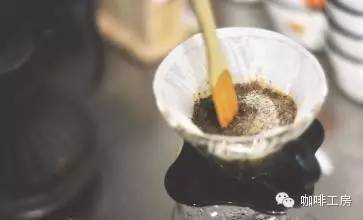
[hand coffee brewing skills] how to stir to make your hand brew coffee better?
Exchange of professional baristas follow the coffee workshop (Wechat official account cafe_style) hand-brewed coffee is really a great idea in the coffee industry, through smooth water filling, the coffee powder gently tumbles in the filter cup to extract the charming flavor, penetrate the filter paper and quietly drip the clear wine red liquid, everything seems so elegant and fresh, full of ritual. The most important thing, of course, is that
- Next
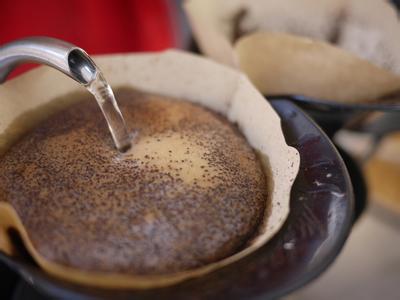
Translation of the selected chapters of the Professional baristas Handbook | Chapter 8 the relationship between water and coffee
Professional barista communication please pay attention to the coffee workshop (Wechat official account cafe_style) hydrochemistry 101in the boutique coffee industry, hydrochemistry has not received the attention it deserves. You may have heard that 98.75% of coffee is water, but few people realize how much water affects the remaining 1.25%. Carbon-filtered water may taste good alone.
Related
- What is the meaning of lactic acid fermentation with coffee bean treatment?
- How to judge the state of foam by sound?
- How does the latte pull out the unicorn pattern? Come to get for a little trick to improve the flower pull!
- Will flower pulling affect the taste of the latte?
- Do you know the history of coffee?
- The difference between honey treatment and sun washing what is raisin honey treatment?
- What kind of milk can a novice use to make coffee foam to keep the foam longer? The correct method and skills of milking tutorial sharing
- Why do washed coffee beans taste sour? Flavor characteristics of washed Coffee
- Introduction to the skill of how to practice the size and height of water injection around the circle of hand-brewed coffee
- How do beginners practice coffee flower drawing from scratch?

